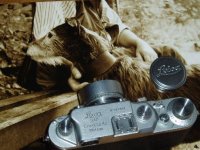Leica_Magus said:
H
Have you any suggestions for an optimum way to scan my Leica prints within the limits imposed for posting here, keeping in mind that 99% of my work is in black and white (as to size, percentage, resolution, B&W or colour scanning, etc.)?; I'd certainly like to share some of me new work with you, as well as optimally scan some older, non-Leica images.
Many thanks in advance for any assistance on this and again, thanks for the warm welcome.
Gong back to the starter question , which was a scanning question but turned into a "glow" discussion after three posts, I'd like to add some more remarks.
Actually each good film scanner like a minolta 5400 for example is able to capture the "footprint" of a lens quite decently, tho a inkjet print from the scanfiel will maybe differ from an enlarger print.
Most important tho is that the postprocessing is done carefully enuff to get the jepg close to the neg or slide. Still there are folks who think the scanner output is the final product and that's it. The scanners output is an digital and thus altered something, it isn't more than a raw basis for the postprocessing.
The better the scanner the better this raw basis will be tho, no question. But as I said, even a KM 5400 or Nikon Coolscan V can catch a special footprint (microcontrast) very well in principle., even my Epson 4490 faltbed can do that in a limited way.
Concerning the glow I'd like to say that (like for bokeh) I have read in the www and heard so much incompetent nonsense that I just refuse to use this word.
You speak about microcontrast and tho I am not sure if this is not one of those ingenious inventions of EP, it is at least describing a real optical effect . So let's say glow=microcontrast, as it is your understanding too.
This article in Luminous Landscape
http://www.luminous-landscape.com/columns/sm-02-04-28.shtml
sums up perfectly my own understanding of glow.
Conclusion tho must be, that the whole production chain contributes to the glow-effect, lens, light, film, dev., enlarger and paper.
Summa summmarum it is the esthetical effect of a technical environment of former times, let's say before 1955-60 and it is the reproduction of a style which was based on the technical conditions of those days.
Micro contrast is just one contributing element and tho even modern asph. Leica lenses undoubtedly have a different "look" concerning the microcontrast, different for example from the Zeiss look, they won't ever achieve the glow effect Mike Johnston describes in the above mentioned article and for which you do not need special Leica lenses but lenses of a certain age and design in general.
There are even old Zeiss lenses which you can make "glow"., not to speak of older
6X6 and 6X9 cameras.
Amazing to see how much people still like that look today and the question appeals if the engineers haven't overdone it on their search for 35mm film perfection, which was driven from the very beginning on by the intention to make 35mm cameras beeing an almost full replacement of 120 film.
bertram
.


